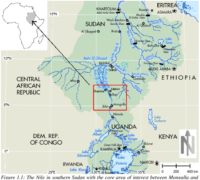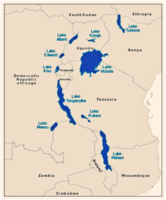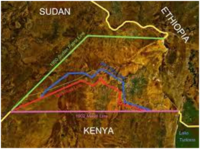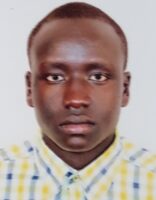
Background
The great lakes region and the Sudd are located in Eastern Africa in a place that famous anthropologist late Louis Leakey described as the cradle of man. His research in the region and anthropological discoveries led to the conclusion that “Sub-Saharan Africa climate as the world shifted from the ice age was ideal for evolution and settlement of early man.” The savannah and abundance of water masses allowed food abundance and settlements (Leakey, 1965).
Therefore, taking from great Louis Leakey, we can conclude that the region in the maps has abundant resources suitable for the human race. It has a climate that promotes population growth, being suitable tropical most of the year, abundant water sources, and suitable flora for animals. In modern times the region accommodates a population of six hundred million individuals (World Population Review, 2022). Compared to the small groups of ancient men, there is significant pressure on resources in the region.
Being an inhabitant of the region and being raised in a period of two civil wars, and having parents from two volatile nations, I can conclude it is the ‘land of men.’ Referencing the two maps, data and studies, including the ones by Louis Leakey have shown most settlements are near water masses. A direct relationship exists between the size and alkalinity of a water mass and the size of a settlement, seasonality being permanent and constant. The water masses and scarce resources are, therefore, a spark of communal, national, and state-funded conflict.
As African countries became independent, the perception has been of politically induced conflicts with international backing, which is only half of the picture. Nearly all countries in the region have experienced an internal disturbance that states have tried to control or crash quickly. In Kenya, it was the Shifta menace and tribal militias battling it out for autonomy and scarce resources. Similar incidents have manifested in Uganda in the Karamoja region, Ethiopia along the Omo River, evidenced by Bruce Parry, South Sudan along the Nile and Sudd, and the great lakes in the Congo.

Gun Culture
The origin of the gun culture in the region can be traced to the political instability created as a result of the cold war as the west, and the east made pawns of us. Rebellions became a daily terminology in most countries; in Nairobi, there was a special spot in most newspapers to assess the ‘Shifta’ menace. One conflict in one country, such as the Sudanese civil war, saw the availability of weapons in another country as sister communities battered goods. A good example is the correlation of communities in the volatile Ilemi triangle.

The poison soon spread into the hands of linguistically and culturally linked communities. A pastoralist community used to holding spears and the shepherd’s staff was soon armed with AK 47s’ machine guns (PKMs), and explosives. A good example is the story of one Turkana family who had to evolve due to the Shifta menace in 1990s Kenya (Al-Jazeera, 2015). There is a Nordic saying, ‘we met the devil, and he became a part of us.’ The communities evolved quickly into dreaded militias that adopted Shifta culture of murder and rustling.
State agencies have adopted countermeasures in all nations in the region. They include a direct counter-insurgency, economic empowerment, and incentivized disarmament. Taking South Sudan as a good case study, the United Nations, as well as the national army, have utilized all strategies discussed. A relative of mine led disarmament in Jonglei state in collaboration with United Nations Mandate for South Sudan. This was in September 2012, only to be countered by a civil war that engulfed the disarmed communities. The result was the rearmament and utilization of communal armies, the most famous white army (Tribune, 2012).
State support evident in many dimensions of tribal militias is from direct community representatives with prosecutions in all countries. Members of the community in the national army particularly provide ammunition and intelligence to their traditional militias. Another support mechanism is the state intelligence engine from a strategic perspective. In the case of the Ilemi triangle, tribal militias are utilized to fight for the state and hold its claim in the disputed region.
Stability, Destruction, and Migration
KTN (2019) confirm the claim that states in the Ilemi triangle and the region are involved in funding border tribal militias for their strategic interests. This can be considered a deal with the devil, considering the banditry activities of the state-funded militias. The state contemplating whether to continue funding their militias and are under-resourced is forced to bow to the militia kingpins. In the Ilemi triangle, state authorities from Ethiopia, South Sudan, Uganda, and Kenya are forced to be pawns to flourish in the inter-border gun trade without their knowledge.
One militia group allied with one from Ethiopia looted police and an army camp on the same day before splitting their loot. The cultural and linguistic identity of these communities is greater than the colonial-drawn borders at times. International criminal law is also complicit with the states who support their respective militias. One group will destroy countless villages and hide in their ‘cousins’ safehouse across the border upon pursuit. Authorities in the states agree with the adage, ‘It is better the devil you know than the one you do not know.’ The point, however, remains that they are still a bandit militia who should not possess arms.
The same problem is faced in the Wundit triangle in South Sudan and the contested Abyei box and Heglieg (Golden triangle). The Wundit triangle is a region between three states in South Sudan and is a meeting point of traditional enemies. It is volatile and experiences regular tribe militia fighting. The Golden Triangle is of strategic interest for both Sudan and South Sudan and is under the United Nations Interim Force of Abyei. Despite the regular clash of parties, South Sudan and Sudan offer support to forces within the box- the South Sudan People’s Defense Force ‘police’ is present, along with Khartoum’s ‘People’s Defense Force ‘police.’
The pearl of Africa, the great Congo, also has a foreign-fueled gun culture with militias fighting for control of resources. Goma ‘volcano’ is truly volatile with foreign-funded militias, and the most famous is the Ituri province tribal fighting. Ituri conflict has forced the intervention of a United Nations Mission to mediate between Lendus and Himas as well as other hungry organized forces. The Great Lakes Region and the Sudd can therefore be termed as a boiling pot that had already spilled over only to calm down.
Should African states be considered guilty of the destruction caused by the immigration crisis in Europe and Asia (Middle East)? The militia’s angel and devil game has led to the death of countless, instability, and a destructive parallel economy. In the quest for strategic interest, states have turned against their own kind. The consequence is the marginalization of trigger-happy society, a banditry economy, and most recently, a counter-insurgency against perceived weak and corrupt state agencies.
South Sudan has seen state-funded tribal militias turn into uncontrolled looting and chaos similar to Ethiopia, the Ilemi triangle in Kenya, the Wundit triangle, Golden Valley, Kerio Valley, and Ituri Province. The major effect of the war has been displacement, and the side effect is mass migration. A documentary that I reviewed, “We Make it or Die by BBC Africa,” highlights the perils of migrants on irregular pathways. Hundreds of thousands of citizens from the region waste resources and time and risk their lives to seek safety in other continents or countries.
Conclusion and Recommendation
Based on the publication findings, several factors led to internal conflict in the Sudd and Great Lakes Region states. The primary factor is the state involvement at the local representative level and strategic interests, be it territory or mineral wealth. International partners and local stakeholders led by the United Nations, International Organization for Migration, and International Police Organization should audit all states in the region. Cartels in the state implicated in arming tribal militias should be sanctioned and tried according to international law.
International gun cartels associated with corrupt and unpatriotic militia kingpins should have their licenses revoked and tried in regional and international courts. A campaign to counter the gun culture and give communities confidence should be undertaken in collaboration with local state authorities and non-governmental organizations. The campaign should be a regional effort pioneered by major international partners with a good metric code over a long-term period. Heavy investment, local empowerment, and constant assault on the international and local cartels should be part and parcel of the process.
In areas such as the Ilemi and Golden Triangle, a final solution should be reached amongst the various states. Cold war tactics such as the use of parallel armed forces in border areas should stop so that the peace prevails. As the region federalizes, territorial integrity should be less focused than strategic collaboration, such as the congruence of economic zones. In the Ilemi triangle, Kenya, Uganda, South Sudan, and Ethiopia should utilize mineral resources for a unitary city for every East African. Like the Abyei and Heglieg box (Golden Triangle), territories can also be transferred upon agreement but with a compensation model.
President Uhuru Kenyatta stated, ‘Borders are rather temporary such as the case of the African borders a result of an imperialist conference. Therefore, we should seek to work together and benefit each other for we are linked culturally, linguistically, and all of us are African.’
References
AlJazeera, E. (2015 ). Kenya: Blood and land: Erodo’s Story . Nairobi : Al Jazeera .
Kenya, N. T. (2019). Gun-tooting run deadly cattle rustling syndicate . Nairobi : Youtube.
Leakey, L. (1965). Olduvai Gorge. Niarobi: Cambridge University Press.
Tribune, S. (2012). Jongelei Disarmament . Juba.
World Population Review. (2022). East African Countries 2022.

Benedict Kuol is a finance major graduate from Strathmore University in Nairobi Kenya. He is also a student of Global Compact for Migration and a research Intern at GRDFT India. He is passionate about writing and research and aims to write and publish several books.
